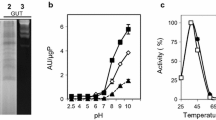Abstract
The entomopathogenic fungus Paecilomyces farinosus showed proteolytic activity in both solid and semi-liquid culture with gelatin as sole N and C source. Semi-liquid cultures were used to characterise proteases. Zymography of crude culture filtrates showed several bands of gelatin degradation in electrophoresis gels. Gel filtration chromatography of these filtrates revealed two peaks of proteolytic activity. Ion-exchange absorption eliminated gelatin from culture filtrates while retaining activity and was used to semipurify P. farinosus proteases. Semipurified culture filtrates had basic pH (8.5 approx.) optimum for proteolytic activity. Treatment of these filtrates with effectors revealed that P. farinosus proteases are serine proteases containing sulphydryl groups. Isoelectrofocusing combined with zymography revealed the presence of several active basic isoforms. Larvae of the lepidopteran Galleria mellonella showed cuticle damage and protein release 1h after incubation with semipurified extracts of P. farinosus. These results indicate that proteolytic enzymes could be involved in insect host penetration by P. farinosus.
Similar content being viewed by others
References
Andersen SO (1985) Sclerotizacion and tanning of the cuticle. In Kerkut GA & Gilbert LI (eds.) Comprehensive insect physiology, biochemistry and pharmacology, pp 59–74. Oxford. Pergamon
Bidochka MJ, Khachatourians GG (1987) Purification and properties of an extracellular protease produced by the entomopathogenic fungus Beauveria bassiana. — Applied and Environmental Microbiology 53: 1679–1684
Bidochka MJ, Khachatourians GG (1994a) Protein hydrolysis in grasshopper cuticles by entomopathogenic fungal extracellular proteases. — Journal of Invertebrate Pathology 63: 7–13
Bidochka MJ, Khachatourians GG (1994b) Basic proteases of entomopathogenic fungi differ in their adsorption properties to insect cuticle. — Journal of Invertebrate Pathology 64: 26–32
Bonants PJM, Fitters PFL, Thijs H, Den Belder E, Waalwijjk C, Willem J, Henfling DM (1995) A basic serine protease from Paecilomyces lilacinus with biological activity against Meloidogyne hapla eggs. — Microbiology 141: 775–784
Bradford MM (1976) A rapid and sensitive method for the quantification of microgram quantities of protein utilizing the principle of protein-dye binding. — Analytical Biochemistry 72: 248–254
Charnley AK (1997) Entomopathogenic Fungi and their Role in Pest Control. In Wicklow DT & Söderström B (eds.) The Mycota IV. Environmental and Microbial Relationships, pp 185–201. Berlin, Heidelberg. Springer
Griesch J, Vilcinskas A (1998) Proteases released by entomopathogenic fungi impair phagocytic activity, attachment and spreading of plasmatocytes isolated from haemolymph of the greater wax moth Galleria mellonella. — Biocontrol Science and Technology 8: 517–531
Jansson HB, Lopez-Llorca LV (2001) Biology of Nematophagous Fungi. In Misra JK & Horn BW (eds.) Trichomycetes and Other Fungal Groups: Professor Robert W. Lichtwardt Commemoration Volume, Science Publishers, Inc., pp 145–173, Enfield (NH), USA
Joshi L, St Leger RJ, Bidochka MJ (1995) Cloning of a cuticle-degrading protease from the entomopathogenic fungus, Beauveria bassiana. — FEMS Microbiology Letters 125: 211–218
Laemmili UK (1970) Cleavage of structural proteins during the assembly of the head of bacteriophage T4. — Nature 227: 680–685
Lopez-Llorca LV, Olivares-Bernabeu C (1994) Crisálidas de procesionaria del pino (Thaumetopoea pityocampa) infectadas por el hongo entomófago Paecilomyces farinosus. — Boletin de la Sociedad Micologica de Madrid 19: 187–191
Lopez-Llorca LV (1990) Purification and properties of extracellular proteases produced by the nematophagous fungus Verticillium suchlasporium. — Canadian Journal of Microbiology 36: 530–537
Lopez-Llorca LV, Carbonell T, Salinas J (1999) Colonization of plant waste substrates by entomopathogenic and mycoparasitic fungi-a sem study. — Micron 30: 325–333
Margaritis LH (1985) Structure and physiology of the Egg shell. In Kerkut GA & Gilbert LI (eds.) Comprehensive Insect physiology, Biochemistry and Pharmacology, Vol 1, pp 153–230. Pergamon Press
Pan SQ, Ye XS, Kuc J (1991) A technique for detection of chitinase, β-1,3-glucanase, and protein patterns after a single separation using polyacrylamide gel electrophoresis or isoelectrofocusing. — Phytopathology 81: 970–974
Samuels RI, Charnley AK, St Leger RJ (1990) The partial characterisation of endoproteases and exoproteases from three species of entomopathogenic entomophthorales and two species of deuteromycetes. — Mycopathologia 110: 145–152
Shimizu S, Tsuchitani Y, Matsumoto T (1993) Serology and substrate sprecificity of extracelular proteases from four species of entomopathogenic hyphomycetes. — Journal of Invertebrate Pathology 61: 192–195
Segers R, Butt TM, Carder JH, Keen JN, Kerry BR, Peberdy JF (1999) The subtilisins of fungal pathogens of insects, nematodes and plants: distribution and variation. — Mycological Research 103: 395–402
St Leger RJ, Cooper RM, Charnley AK (1987) Production of cuticle-degrading enzymes by the entomopathogen Metarhizium anisopliae during infection of cuticles from Calliphora vomitoria and Manduca sexta. — Journal of General Microbiology 133: 1371–1382
St Leger RJ, Frank DC, Roberts DW, Staples RC (1992) Molecular cloning and regulatory analysis of the cuticle degrading-protease structural gene from the entomopathogenic fungus Metarhizium anisopliae. — European Journal of Biochemistry 204: 991–1001
St Leger RJ (1993) Biology and Mechanism of insect-cuticle invasion by Deuteromycete fungal pathogens. In Beckage NE, Thompson SN, Federici BA (eds.) Parasites and pathogens of insects. Vol 2: Pathogens, pp 211–229. San Diego, USA: Academic Press
St Leger RJ, Joshi L, Bidochka MJ, Roberts DW (1996) Construction of an improved mycoinsecticide overexpressing a toxic protease. — Proceedings of the National Academy of Sciences USA 93: 6349–6354
Tikhonov VE, Lopez-Llorca LV, Salinas J, Jansson HB (2002) Purification and Characterization of Chitinases from the Nematophagous Fungi Verticillium chlamydosporium and V. suchlasporium. — Fungal Genetics and Biology 35: 67–78
Whrton DA (1980) Nematode egg-shells. — Parasitology 81: 447–463
Author information
Authors and Affiliations
Corresponding author
Rights and permissions
About this article
Cite this article
Lopez-Llorca, L.V., Carbonell, T. & Gomez-Vidal, S. Degradation of insect cuticle by Paecilomyces farinosus proteases. Mycol Progress 1, 249–256 (2002). https://doi.org/10.1007/s11557-006-0022-y
Accepted:
Issue Date:
DOI: https://doi.org/10.1007/s11557-006-0022-y




